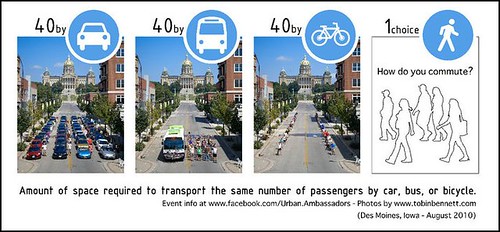Boston Globe's Courtland Milloy moment on bicycling
 JOSH REYNOLDS FOR THE GLOBE/FILE. Bicycle commuters were spotted near Porter Square in 2011.
JOSH REYNOLDS FOR THE GLOBE/FILE. Bicycle commuters were spotted near Porter Square in 2011.Jeff Jacoby, one of the Boston Globe's columnists, wrote a piece earlier in the week ("Urban roads aren't meant for bicycles") arguing that bicycles don't belong on the roads, but are fine for recreational use.
Courtland Milloy, a Washington Post columnist, wrote similar screeds ("Bicyclist bullies try to rule the road in DC" and "Give bicyclists their own roads") a few years ago. The second piece is a bit of back pedaling, claiming that everyone would be better off (and it's true) if we had an integrated system of off-road bikeways.
The comments on the Globe article rehash the perennial and typical arguments, pro and con.
I don't know Boston very well, but the reality is that the cities, including Boston, which developed during the "Walking City" (1800 to 1890) and "Transit City" (1890 to 1920) eras are designed to optimize walking, biking, and transit, not motor vehicles.
Not to mention how bicycles take much less space than cars, which is evident in the photo above. Image that space with 10 or more vehicles competing for limited road space.

Urban Ambassadors, Des Moines, Iowa
Later in the week, the Globe ran a mea culpa piece, "Thinking beyond the bike lane," summarizing the various advances in infrastructure and the general state of "biking as transportation" in the area, although the article didn't mention the City of Boston's Boston Bikes program, which among other accomplishments, has initiated a number of pathbreaking programs to promote social equity within biking as transportation programming.
One of the projects mentioned is the Arlington Center Safe Travel Project, which will provide a high quality connection between different legs of the otherwise off-road Minuteman Bikeway, using street right of way.
The article is interesting in how it reiterates that the process of change and improvement, in this case for biking, takes a long time, especially when multiple jurisdictions are involved, and when the mobility system preferences motor vehicle traffic.
Ironically, but it shouldn't be a surprise, US newspaper columnists like Jeff Jacoby and Courtland Milloy are decidedly behind the times in terms of innovative thinking at the global scale, as The Economist reports, in "Streetwise: Cities are starting to put pedestrians and cyclists before motorists. That makes them nicer—and healthier—to live in." From the article:
Four wheels bad, two wheels good
In cycling, Amsterdam and Copenhagen are the pacesetters, with a third of trips made by bicycle. More than half of Amsterdam’s residents use their bikes daily. London, New York and Paris all have plans to challenge them. All three cities are expanding their bike-share schemes and building new bike lanes, some on quiet roads with new, lower speed limits for cars, and others running through central areas and separated from motorised traffic.
Such schemes can quickly convince more people to start pedalling. They are particularly popular with women, who transport planners say are more nervous than men about sharing roads with roaring traffic and typically make up less than a quarter of urban cyclists. In 2007-2010 the Spanish city of Seville built an 80km network of separated two-way bicycle lanes; the share of trips in the city that were by bicycle went from nearly zero to 7%. In Taipei few women cycled before its YouBike share scheme started in 2009; now they are half of the city’s cyclists. ...
... Both bikes and public transport are more likely to be used when bike racks are placed on the front of buses, as in Boston and Washington, DC, and secure parking is provided at rail stations.
In 2014 Britain’s transport ministry looked at recently built cycling and walking infrastructure in eight cities. Standard cost-benefit analyses for planned transport infrastructure include a value for the lives saved (or lost) through changes in the number of accidents. Using the same figures for the lives prolonged by increased activity, it found that the cost of the schemes was repaid three-fold—and again in reduced congestion. London’s authorities calculate that if every Londoner switched to walking for trips under 2km, and to cycling for trips of 2-8km, the share who got enough exercise to remain healthy simply by getting around would rise from 25% to 60%. That would amount to 61,500 years of healthy life gained each year.
Labels: bicycle and pedestrian planning, car culture and automobility, transportation planning, urban design/placemaking



2 Comments:
ditto that bicycles should not be on roads- I find roads far too dangerous to bicycle on and why anyone would want to do this voluntarily is weird and ultimately suicidal. Vehicular Cycling does not work-period. Give us our own areas to bike on in the city and all will be fine as long as the aggressive male sports cyclists are pacified or put down- even put away- these guys are the real problem .
Thank you for providing such a valuable information and thanks for sharing this matter. to get Online pharmacy from online medicine store.
Post a Comment
<< Home